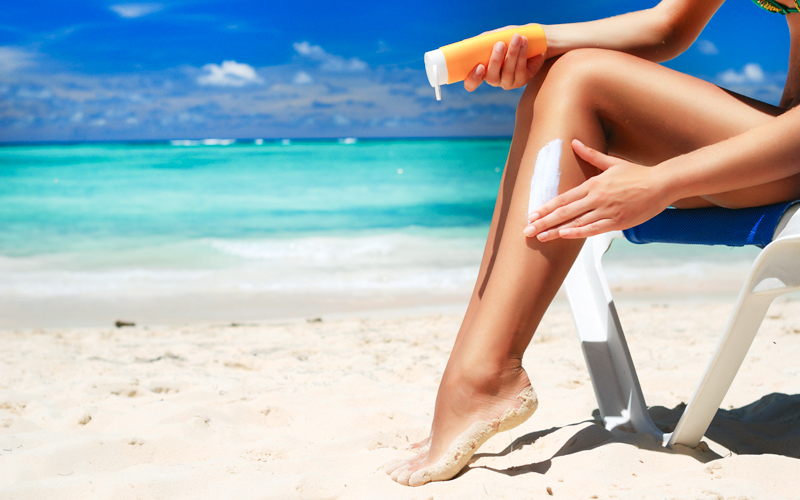
by guest blogger Ava Anderson, natural-beauty expert and safe-cosmetics advocate
Here comes summer—and the SUN! Finally, that long winter is in our rearview mirror. But did you know that UV rays become more intense in the spring, even before the temperatures get warmer?
That means it’s sunscreen time. But with so many choices, how do you decide? I am here to help you navigate, because I simply cringe at the sun-protection products I see people putting on their skin these days.
Here are SEVEN shocking facts you need to know to find a safe sunscreen!
1. SPF is not an accurate predictor of protection. Surprised? The SPF number on your sunscreen only rates protection from UVB rays, those that cause sunburn—think “B” for bad burn—not UVA rays, those that cause wrinkling, leathering, aging skin, and long-term damage—think “A” for aging. Crazy, right? You can be baking in the sun, not burning, and think you’re protecting yourself from skin cancer. You could, however, be very wrong. It’s important to protect against both UVA and UVB rays because both types cause melanoma.
2. UVA rays are constant all year long and can penetrate glass! Be sure your sunscreen provides broad-spectrum coverage for both UVA and UVB rays to protect yourself year-round.
3. Chemical “active ingredients” are “no-no’s.” Sadly, ingredients like oxybenzone, octinoxate, avobenzene, octycrylate, and homosalate are in most of the sunscreens sold at big-box stores, including children’s sunscreen. There are just 17 FDA-approved ingredients for sun protection: 15 are clear chemicals that absorb UV light, and nine of those 15 are known endocrine disruptors—dangerous chemicals that alter the natural function of the body’s hormones, including estrogen, progesterone, testosterone, and thyroid. Endocrine disruptors can cause abnormal development in fetuses and growing children, early puberty and premature breast development in girls, low sperm counts in men, and infertility. If that’s not enough, some may generate DNA-damaging chemicals called “free radicals” in the body, and they can lead to cancer.
These chemical active ingredients operate by penetrating the skin, promoting indirect DNA damage, which causes the most lethal form of skin cancer: malignant melanoma. You read that correctly, your sunscreen could be causing cancer! Use a physical blocker—a mineral sunscreen (the two FDA-approved mineral ingredients are zinc oxide and titanium dioxide)—to keep the sun protection on the surface of your skin. These ingredients provide broad-spectrum UVA/UVB protection without the harmful potential disease implications.
4. Your mineral sunscreens, zinc and titanium, are most likely nanoparticle size. What exactly does this mean? Remember the lifeguards at the pool with white stripes on their noses? That’s what zinc looks like. Most manufacturers use miniscule pulverized particles of zinc or titanium to make them easier to spread on and disappear (no white nose). Campaign for Safe Cosmetics posts this warning: “Beware personal care products that tout use of nanoparticles, nanomaterials, or nanotechnology. This emerging technology is almost entirely untested for its health effects, and no requirements exist for either testing or labeling these products to make sure consumers are both safe and informed. That means that you might be getting a dose of nano without even knowing it. Preliminary scientific research has shown that many types of nanoparticles can be toxic to human tissue and cell cultures, resulting in increased oxidative stress, inflammatory cytokine production, DNA mutation, and even cell death. They can penetrate cell walls, including organ tissues, and are known to be highly reactive.” The verdict is still out on nanoparticle zinc and titanium, but I’m not willing to be the guinea pig.
5. An ingredient that enhances skin cancer lesions is found in many sunscreens! What? Beware of retinyl palmitate, a combination of retinol and palmitic acid. As the Environmental Working Group (EWG) reports, “A study by U.S. government scientists suggests that retinyl palmitate may speed the development of skin tumors and lesions when applied to the skin in the presence of sunlight.”
6. The paraben preservatives in your sunscreen are also known endocrine disruptors and suspected carcinogens. Avoid sunscreens (and any other products) with parabens—methylparaben, ethylparaben, propylparaben, and such. A 2012 physician study showed that methylparaben, in combination with BPA, turned healthy breast cells into cancer cells and rendered tamoxifin ineffective. Avoid all parabens.
7. Manufacturers can legally hide hundreds of toxic chemicals in the “trade-secret” ingredient “fragrance” or “parfum.” That coconut smell is not real, and most likely comes with a dose of phthalates (more endocrine disruptors!) and other toxic chemicals. Avoid synthetic fragrances.
How to find the safest sunscreens? Read labels and look up your sunscreen on EWG’s Skin Deep cosmetics database. Because it really is “all about the ingredients.”
The database ranks products on a 0 to 10 toxicity scale. The sunscreen I used to use is ranked an 8 in toxicity (ouch). Most sunscreens on the endcaps in your local big-box store are ranked 6 through 9 (in the “highest toxic hazard” range). Some contain ALL four endocrine-disrupting offenders discussed above! Now think of how many times you reapply sunscreen to yourself and your little ones in hopes of daily “protection.”
Steps to Safe Sunscreen Application
1. Apply sunscreen liberally to dry skin 30 minutes before going outdoors, taking extra precaution to cover exposed areas.
2. Sunscreen should be reapplied every two hours, or
half that time when near the water or after swimming, showering, or
sweating. No sunscreen can legally claim to be waterproof.
3. Avoid exposure from the strongest sun (between 10 a.m. and 4 p.m.) when possible.
4. Cover up—go wild and top if off with a great hat!
NOTE: We do not share the information on harmful chemicals in personal care products and sunscreen to sell my products; rather we created the line to share this message. It bothers me to see people I care about as well as absolute strangers, especially pregnant women and small children, slathering toxic products on their skin.
We are really proud of Ava Sunscreen 35 SPF.It’s a great moisturizer that doubles as a sunscreen. It includes five certified-organic, botanical ingredients with no chemicals harmful to humans or the environment.
Yes, you do need to rub it in a bit, but, now that you have some key facts, isn’t a little elbow grease worth it?
 At the age of 15, Ava Anderson launched her own line of personal care and home-cleaning products, Ava Anderson Non-Toxic.
Now 20, Ava is educating hundreds of thousands of American families
annually on the issue of toxic chemicals in personal care products
through her line, which now includes baby, skin, face, hair, body,
scents, bugs, candles, home, sun, and pet products. As an undergrad at
Babson College in Wellesley, Massachusetts, Ava actively helps run her
multimillion-dollar empire with 17 full-time employees. Her goal is to
help force a paradigm shift on the issue of toxic chemicals in
products.
At the age of 15, Ava Anderson launched her own line of personal care and home-cleaning products, Ava Anderson Non-Toxic.
Now 20, Ava is educating hundreds of thousands of American families
annually on the issue of toxic chemicals in personal care products
through her line, which now includes baby, skin, face, hair, body,
scents, bugs, candles, home, sun, and pet products. As an undergrad at
Babson College in Wellesley, Massachusetts, Ava actively helps run her
multimillion-dollar empire with 17 full-time employees. Her goal is to
help force a paradigm shift on the issue of toxic chemicals in
products.


